Messerschmitt Bf 108 Video - Overview
|
|
Messerschmitt Bf 108
Bf 108 Taifun
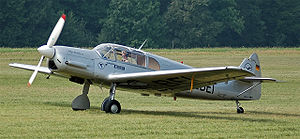
Picture - Lufthansa's Bf 108 B-1, D-EBEI
Role: Communications
Manufacturer: Bayerische Flugzeugwerke
Designed by: Willy Messerschmitt
First flight: 1934
Introduced: 1935
Retired: 1945
Primary users: Luftwaffe
Armée de l'Air
Manchukuo National Airways
Number built: 885
Variants: Nord 1000
Nord Noralpha
The Messerschmitt Bf 108 Taifun was a German single-engine sports and touring aircraft developed by Bayerische Flugzeugwerke (Bavarian Aircraft Works). The Bf 108 was of all-metal construction. The Bf 109 fighter used many of the same design features.
Design and development
Originally designated the M 37, the aircraft was designed as a four-seat sports/recreation aircraft for competition in the 4th Challenge de Tourisme Internationale (1934). The M 37 prototype flew first in spring 1934 powered by a 250 PS (247 hp, 184 kW) Hirth HM 8U inverted-V engine, which drove a three-blade propeller.
Although it was outperformed by several other aircraft in the competition, the M 37's overall performance marked it as a popular choice for record flights. Particular among these traits was its extremely low fuel consumption rate, good handling, and superb takeoff and landing characteristics. One of the first major changes made to the production variants was to adapt the fuselage for a four-seat configuration.
The Bf 108A first flew in 1934, followed by the Bf 108B in 1935. The Bf 108B used the Argus As 10 air-cooled inverted V8 engine. The nickname Taifun (German for "typhoon") was given to her own aircraft by Elly Beinhorn, a well known German pilot, and was generally adopted.
Operational history
Soon after the first production aircraft began to roll off the assembly line in Augsburg, several Bf 108s had set endurance records.
The Bf 108 was adopted into Luftwaffe service during World War II, where it was primarily used as a personnel transport and liaison aircraft. The plane involved in the Mechelen Incident was a Bf 108.
Production of the Bf 108 was transferred to occupied France during World War II and production continued after the war as the Nord 1000 Pingouin.
Variants
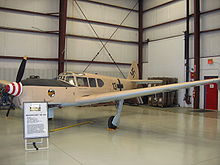
Picture - A Nord Noralpha painted to represent an Me 208
M 37/Bf 108A Initial version designed in 1934 for use in Challenge 1934. Six were built with the Hirth HM 8U, one other initially had a 220 PS (217 hp, 162 kW)Argus As17B inline engine and later a 160 PS (158 hp, 118 kW) Siemens Sh14A radial. Bf 108B Revised version, built from late 1935. Prototype had a Siemens Sh14A radial, but production machines used the 240 PS (237 hp, 177 kW) Argus 10C or the 270 PS (266 hp, 199 kW) Argus 10E. Quadrant shaped rather than rectangular rear window, tailwheel replacing skid, revision of shape of empennnage and removal of tailplane upper bracing. Bf 108C Proposed high-speed version, powered by a 400 PS (395 hp, 294 kW) Hirth HM 512 engine. Probably not built. Me 208 Improved and enlarged version with a retractable tricycle landing gear. Two prototypes were built by SNCAN (Nord) in France during the war. After 1945 Nord continued its production as the Nord Noralpha. A Nord Noralpha is on display at the Valiant Air Command Warbird Museum in Titusville, Florida, United States which has been painted to represent an Me 208. Nord 1000 Pingouin Bf 108 built during and after the war by SNCAN in France; followed by the Nord 1001, that had only minor variations and the Nord 1002 which used a Renault engine.
Operators
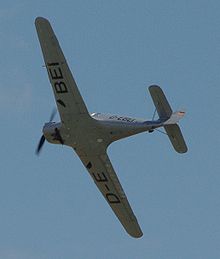
Picture - Bf 108 B-1, Lufthansa's D-EBEI at Duxford 2009
Brazil
Varig
Bulgaria
Bulgarian Air Force
China
Chinese Nationalist Air Force
Czechoslovakia
Czechoslovak Air Force operated this type post war under designation K-70.
France
Armée de l'Air operated captured Bf 108s and postwar built Nord 1000 aircraft.
Germany
Luftwaffe
Japan
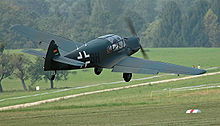
Picture - Bf 108B Taifun, Messerschmitt-Stiftung
Imperial Japanese Army Air Service
Manchukuo
Manchukuo National Airways
Poland
Polish Air Force operated a few captured Bf 108s postwar.
Switzerland
Swiss Air Force

Picture - The Bf 108 as used by the Swiss Air Force during World War II. Aviation Museum (Flieger Flab Museum) in Dx¼bendorf, Switzerland.
Soviet Union
Soviet Air Force operated several captured Bf 108s.
United Kingdom
Royal Air Force
RAF Aldon
Impounded four Bf 108s on the outbreak of World War II and put into service, where they were designated Messerschmitt Aldon. As a light communications aircraft, it was the fastest type the RAF had at the time, but they caused some confusion by being mistaken for attacking Bf 109s. Post-war, 15 more captured Bf 108s flew in RAF colours.
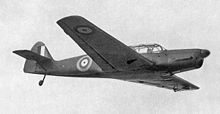
Picture - RAF Aldon
United States
A single Bf 108B was purchased by the U.S. Military Attaché for Air in the spring of 1939 for $14,378 and designated XC-44. It was repossessed by the Nazi government in December 1941 (after having been condemned in November).
Kingdom of Yugoslavia
Yugoslav Royal Air Force
Specifications (Bf 108B)
Data from Jane's AWA 1938
General characteristics
Crew: 1
Length: 8.3 m (27 ft 2 in)
Wingspan: 10.5 m (34 ft 5 in)
Height: 2.3 m (7 ft 6 in)
Wing area: 16 m² (172 ft²)
Empty weight: 806 kg (1,775 lb)
Loaded weight: 1,350 kg (2,976 lb)
Powerplant: 1x— Argus As 10C air-cooled inverted V-8, 240 PS (174 kW)
Performance
Maximum speed: 305 km/h (190 mph)
Range: 1,000 km (620 mi)
Service ceiling: 6,200 m (20,300 ft) with 4 people and baggage
Rate of climb: 5.21 m/s (1,194 ft/m) to 1,000 m (3,048 ft)
Wing loading: 83.4 kg/m² (17.1 lb/ft²)
Power/mass: 0.133 kW/kg (0.081 hp/lb)
Popular culture
Bf 108s and postwar Nord 1000s, played the role of Messerschmitt Bf 109 fighters in war movies, including The Longest Day, 633 Squadron and Von Ryan's Express.
Related development
Nord Pingouin
Comparable aircraft
Klemm Kl 36
Fieseler Fi 97
Bibliography
Craig, James F. The Messerschmitt Bf.109. New York: Arco Publishing Company, 1968.
Cross, Roy and Gerald Scarborough. Messerschmitt Bf 109 Versions B-E (Classic Aircraft No. 2, Their History and How to Model Them). London: Patrick Stevens, 1972. ISBN 0-85059-106-6.
Feist, Uwe. The Fighting Me 109. London: Arms and Armour Press, 1993. ISBN 1-85409-209-X.
Grey, C.G. "Messerschmitt Bf 108." Jane's All the World's Aircraft, 1938. London: David & Charles, 1972. ISBN 0715-35734-4.
Hitchcock, Thomas H. Messerschmitt Bf 108 Taifun (Monogram Close-Up 5). Acton, Massachusetts: Monogram Aviation Publications, 1979. ISBN 0-914144-05-7.
Smith, J. Richard. Messerschmitt: An Aircraft Album. London: Ian Allen, 1971. ISBN 978-0711002241.
Messerschmitt Bf 108 Pictures
Living Warbirds: The best warbirds DVD series.
Source: WikiPedia